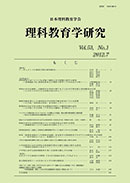
- Issue 3 Pages 1-
- Issue 2 Pages 1-
- Issue 1 Pages 1-
- |<
- <
- 1
- >
- >|
-
Makoto SUZUKI2002Volume 43Issue 1 Pages 1-10
Published: September 10, 2002
Released on J-STAGE: June 30, 2022
JOURNAL FREE ACCESSThe purpose of this study was to determine the influence of self-efficacy on the formulation of learning goals in the science class and to determine ways to improve the self-efficacy of students. The findings of this study include: 1. Students with high self-efficacy scored higher on the various concepts which constitute learning goals. 2. While agency beliefs influence the formulation of learning goals for students with high self-efficacy, teachers influence it most for students with low self-efficacy. 3. Regardless of the level of the student's self-efficacy, cognitive self-appraisal influences the formulation of learning goals. However, cognitive self-management influences it for students with high self-efficacy. 4. Regardless of the level of the student's self-efficacy, the teaching role in social relationships among students influences the formulation of learning goals. However, external expectations influence it for students with low self-efficacy in learning science. 5. Elaboration strategies for learning influence the formulation of learning goals, regardless of the level of the student's self-efficacy.
View full abstractDownload PDF (1027K) -
Asami OHNUKI2002Volume 43Issue 1 Pages 11-18
Published: September 10, 2002
Released on J-STAGE: June 30, 2022
JOURNAL FREE ACCESSThe process of constructing the concept of reproduction through the study of the fish breeding was analyzed by using concept mapping. Sex and fertilization were observed as fundamental concepts in the construction of the reproduction concept. These two concepts were analyzed, and the following points were found. (1) About 50% of the students kept their original concepts about sex throughout the study. (2) All of the students constructed the fertilization concept during the study, and the contents of the fertilization concept were amplified in about 57% of the children by the end of the study. (3) In an analysis using the technique of Fukuoka and Ohnuki (2001), the fertilization concept had 3 points of hierarchy and 6 points of differentiate crossing. At the end of the study, the hierarchy points did not differ much, but the differentiate crossing points showed some divergence between two types of students. The average of the differentiate crossing type students was 4, on the other hand, that of the integrative type was 2. (4) From the observation of the addition of the label "male" in the fertilization concept, the role of the male tended to be slighted in comparison with that of the "female," even after the experience of breeding fish. These results suggest that some problems in constructing the fertilization concept led the students to choose the wrong answer in a test checking the conditions necessary for incubation. (5) It was found that some devices were necessary to construct the concept of the "male" role as essential to the fertilization concept, and concrete plans for such a device were presented.
View full abstractDownload PDF (973K) -
Kouichi MORIMOTO, Keiko MATSUMURA, Yoshiaki ETOH2002Volume 43Issue 1 Pages 19-28
Published: September 10, 2002
Released on J-STAGE: June 30, 2022
JOURNAL FREE ACCESSThis study was carried out in order to evaluate the effectiveness of teaching materials (developed by Morimoto, et al.) for showing the effect of UV radiation on living things. The research project focused on classes for third year students in upper secondary school. Fruit flies, morning glories, and bananas were irradiated using a UV lamp. The effectiveness of the materials was evaluated by student participation, lab reports, questionnaires, and concept maps. As a result, it is clear that morning glories and bananas are useful materials because they encourage students to change and develop their ideas, as evidenced in the concept maps.
View full abstractDownload PDF (1072K)
-
Etsuji YAMAGUCHI, Shigenori INAGAKI, Mayumi FUKUI, Hideo FUNAOI2002Volume 43Issue 1 Pages 29-51
Published: September 10, 2002
Released on J-STAGE: June 30, 2022
JOURNAL FREE ACCESSThe purpose of this study was to review research on concept mapping in order to clarify recent trends. First, we confirmed that concept mapping has been used recently in a wide content area and on various grade levels through examining 35 articles published in international journals and 34 articles in Japanese journals on science education. Second, we divided the history of concept mapping research into three generations. The first generation of research focused on the development of concept mapping, the second on using concept mapping to support the learner's acquisition of knowledge as "individualistic learning, " and the third on using concept mapping to support collaborative learning. Finally, we discussed prospects for future research on concept mapping and their implications for science education.
View full abstractDownload PDF (3024K)
- |<
- <
- 1
- >
- >|